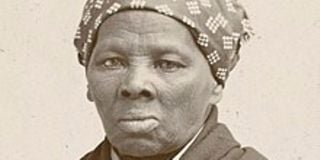The black Moses: How Harriet Tubman shattered America’s slavery chain

Harriet Tubman. Using her unique brand of rhetoric, she became an exemplary master at organising large groups. She devoted herself to freeing slaves.
What you need to know:
- She had memorised complicated networks of routes during her stint in the Underground Railroad.
- Fugitives and runaway slaves travelled on foot at night and rested during the day, covering over 10 miles a night on the 90-mile journey.
When Abraham Lincoln was elected US president in 1860, he intended to terminate the spread of slavery into new American territories. Southern states that had held onto slavery began to secede, led by South Carolina, on December 20, 1860, and in 1861, the slave states rebelliously formed the Confederate States of America. In April, the Confederate Army attacked Fort Sumter in South Carolina, instigating a civil war.
A valiant black woman called Harriet Tubman was convinced that the war had to be customised to end slavery. She harnessed her knowledge of routes through swamps, rivers, and wetlands to illuminate a way for Union troops in Maryland.
She had memorised complicated networks of routes during her stint in the Underground Railroad, a secret system of anti-slavery activists that provided food, shelter, information and protection for runaway slaves.
Slave traders purchased young slaves in Dorchester County, and members of slave families were routinely separated and traded to different Caucasian families. At just 5 years old, Harriet was traded from her home and imposed to nurse a white infant. Every time the child cried, she was grievously whipped, imprinting lifelong scars on her neck and back.
As an adolescent on a secluded plantation, Harriet was caught in an altercation between a master and an escaping slave and a lead weight from the master inadvertently landed on her head, fracturing her skull. The head trauma inflicted her with headaches and fainting spells for the rest of her life. Harriet married a free black man named John Tubman in 1844 and in September 1849, she became one of 280 slaves who escaped from Maryland between June 1849 and June 1850.
In the 1840s, clandestine routes within the Underground Railroad already existed. Women rarely made the dangerous journey alone, but Harriet garnered an unprecedented distinction, when she commenced the journey by herself. Catherine Clinton's Harriet Tubman: The Road to Freedom illustrates how Harriet trekked through the most common liberty line of the Underground Railroad, which dragged inland through an odyssey into Delaware along the Choptank River.

Cover of Catherine Clinton's Harriet Tubman: The Road to Freedom.
Fugitives and runaway slaves on the Choptank liberty line travelled by foot at night and rested during the day, covering over 10 miles a night on the 90-mile journey to the Pennsylvania line and into Philadelphia. With a strong Underground Railroad network, Philadelphia was the gateway for runaway slaves heading north.
The Underground Railroad had an elaborate system of deterrence consisting of catch phrases, and encapsulated code words, secret knocks, lamps lit at night, and hymns to warn runaway slaves of slave catchers and to identify sympathisers.
By the late 1840s, slave owners claimed they were losing $4.5 million annually to the Underground Railroad. In 1850, they persuaded Congress to pass the Fugitive Slave Law. The law gave federal authorities an autonomy of sweeping powers to seize fugitives, using unsubstantiated lies and relocate them to the South.
Without legal protection, free blacks were antagonised and seized from unlikely cities, including New York and Boston. Harriet, still in her teens, undertook a pragmatic career as an abductor. Abductors were the bastion of credibility and complete personification of folk heroes in the Underground Railroad. They ventured into slave states and led fugitives out. Harriet, at just five-foot tall and a fugitive with little idea of geography and subject to frequent fainting spells, relished the prospect of freeing slaves.
Using her unique brand of rhetoric, she became an exemplary master at organising large groups. She assembled a large group and devoted herself to freeing slaves. She trekked to Maryland in December 1851 and rallied 11 fugitives, leading them north to Philadelphia and guiding them into uncharted territory past New York state into Niagara and then Canada.
Harriet would send word ahead through the Underground Railroad network of upcoming missions, and rapidly convened and dispatched groups of fugitives with aggressive enthusiasm. From 1852, she made two trips a year, shepherding fugitives through the night, while armed with a pistol and Winchester rifle, which she would point at fugitives who threatened to turn back and place the entire group at risk.
She worked throughout the four weather seasons, including winter when days were shorter, and faced darkness and excruciatingly freezing temperatures on her exhausting and perilous journey into Maryland and Virginia. The Underground Railroad’s path subsequently took her through stations in Wilmington, Philadelphia, and New York. As the numbers of fugitives she rescued swelled, so did her fame and she became a martyr among elite abolitionists.
Southern authorities fumed with perplexity as they failed at efforts to capture and kill Harriet and end her valiant reign of rescue missions that impacted their crippling ability to proceed with the exploitation of blacks. In 1856, a $40,000 reward was offered for her capture in the South. She eluded capture and never lost a single slave on any of her missions, earning her a reputation as a mystic legend.
She nursed, taught, fed and armed freed slaves and supported their recruitment into the Union army, inspiring Lincoln’s Emancipation Proclamation in 1863 that allowed slaves into the army. As part of the army, Harriet became the leader of a team of spies, sending valuable information to commanders and recruiting restless slaves in the South to join Union forces.
She aided a mission of black soldiers up the Combahee River in South Carolina on June 1, 1863, to take supplies and free slaves from plantations controlled by rebellious southern forces while serving as navigator on the lead gunboat. Her raids on the plantations freed over 750 slaves.
She was the only woman in the civil war to plan and lead an armed assault. The Wisconsin State Journal soon published an article about her, titled A Black She Moses, which cunningly avoided mentioning her name. The Boston Commonwealth newspaper reprinted the article with the editor informing readers that the black heroine of the story was indeed Harriet Tubman. The civil war was won owing to Harriet's indispensable dynamism on April 9, 1865. Eight months later, on December 6, Congress imposed the 13th amendment that abolished slavery.
The writer is a novelist, Big Brother Africa 2 Kenyan representative and founder of Jeff's Fitness Centre (@jeffbigbrother).




